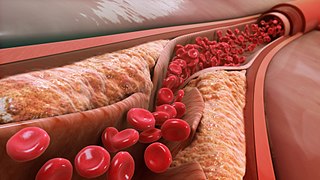
Low-density lipoprotein (LDL) is one of the five major groups of lipoprotein that transport all fat molecules around the body in extracellular water. These groups, from least dense to most dense, are chylomicrons, very low-density lipoprotein (VLDL), intermediate-density lipoprotein (IDL), low-density lipoprotein (LDL) and high-density lipoprotein (HDL). LDL delivers fat molecules to cells. LDL has been associated with the progression of atherosclerosis.

In pharmacology, the fibrates are a class of amphipathic carboxylic acids and esters. They are derivatives of fibric acid. They are used for a range of metabolic disorders, mainly hypercholesterolemia, and are therefore hypolipidemic agents.
ATC code C10Lipid modifying agents is a therapeutic subgroup of the Anatomical Therapeutic Chemical Classification System, a system of alphanumeric codes developed by the World Health Organization (WHO) for the classification of drugs and other medical products. Subgroup C10 is part of the anatomical group C Cardiovascular system.

Zellweger syndrome is a rare congenital disorder characterized by the reduction or absence of functional peroxisomes in the cells of an individual. It is one of a family of disorders called Zellweger spectrum disorders which are leukodystrophies. Zellweger syndrome is named after Hans Zellweger (1909–1990), a Swiss-American pediatrician, a professor of pediatrics and genetics at the University of Iowa who researched this disorder.

Clofibric acid is a biologically active metabolite of the lipid-lowering drugs clofibrate, etofibrate and theofibrate with the molecular formula C10H11ClO3. It has been found in the environment following use of these drugs, for example in Swiss lakes and the North Sea.

Clofibride is a fibrate. Clofibride is a derivative of clofibrate. In the body it is converted into 4-chlorophenoxyisobutyric acid, which is the true hypolipidemic agent. So clofibride, just like clofibrate is a prodrug of clofibric acid.

Etofibrate is a fibrate. It is a combination of clofibrate and niacin, linked together by an ester bond. In the body, clofibrate and niacin separate and are released gradually, in a manner similar to controlled-release formulations.
Simfibrate is a fibrate that has been used for the treatment of hyperlipidemia. The substance is a double ester of clofibric acid with 1,3-propanediol which is cleaved in the body to one molecule of 1,3-propanediol and two molecules of clofibric acid which is the true lipid-lowering agent.

Clofibrate is a lipid-lowering agent used for controlling the high cholesterol and triacylglyceride level in the blood. It belongs to the class of fibrates. It increases lipoprotein lipase activity to promote the conversion of VLDL to LDL, and hence reduce the level of VLDL. It can increase the level of HDL as well.

Peroxisomal membrane protein 11A is a protein that in humans is encoded by the PEX11A gene.

PPAR agonists are drugs which act upon the peroxisome proliferator-activated receptor. They are used for the treatment of symptoms of the metabolic syndrome, mainly for lowering triglycerides and blood sugar.

Phosphatidylcholine transfer protein (PCTP), also known as StAR-related lipid transfer domain protein 2 (STARD2), is a specific intracellular phospholipid binding protein that can transfer phosphatidylcholine between different membranes in the cytosol.
Acefylline clofibrol is a derivative of acefylline and clofibrate used as a hypolipidemic agent.

Tibric acid is a sulfamylbenzoic acid that acts as a hypolipidemic agent. Although it was found to be more powerful than clofibrate in lowering lipid levels, it was found to cause liver cancer in mice and rats, and so was not introduced as a human drug. In rats it causes an increase in peroxisomes, and liver enlargement, and then liver cancer. However the peroxisome changes do not occur in humans, and it is not likely to cause liver cancer in humans.
The Coronary Drug Project (CDP) was a large clinical trial which assessed several different treatments for coronary heart disease in men with previous myocardial infarction. The study was conducted from 1965 to 1985 at 53 clinical centers and randomized 8,341 men age 30 to 64 years to six different treatment groups: low-dose estrogen therapy, high-dose estrogen therapy, clofibrate (1.8 g/day), dextrothyroxine (6 mg/day), niacin (3 g/day), and placebo.











